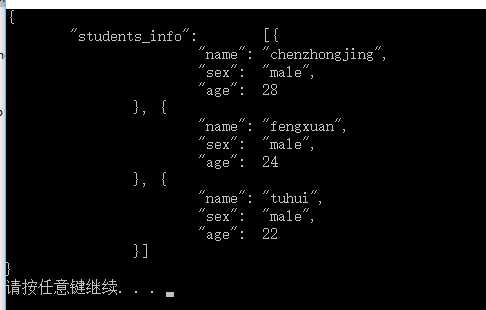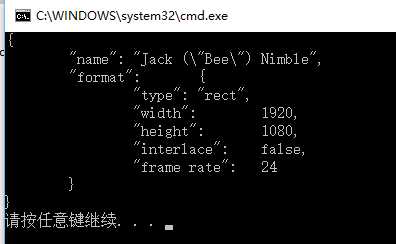标签:
cJSON使用案例
由了解了cJSON的数据结构,接口以及实现之后,那么我们来举例说明其使用。
本例子是一个简单的学生信息表格管理,我们通过键值对的方式向json中增加元素信息。
然后可以格式化输出结果,也能够反向的由字符串输出生成原cJSON对象。
int Test_cJSON() { cJSON* pRoot = cJSON_CreateObject(); cJSON* pArray = cJSON_CreateArray(); cJSON_AddItemToObject(pRoot, "students_info", pArray); char* szOut = cJSON_Print(pRoot); cJSON* pItem = cJSON_CreateObject(); cJSON_AddStringToObject(pItem, "name", "chenzhongjing"); cJSON_AddStringToObject(pItem, "sex", "male"); cJSON_AddNumberToObject(pItem, "age", 28); cJSON_AddItemToArray(pArray, pItem); pItem = cJSON_CreateObject(); cJSON_AddStringToObject(pItem, "name", "fengxuan"); cJSON_AddStringToObject(pItem, "sex", "male"); cJSON_AddNumberToObject(pItem, "age", 24); cJSON_AddItemToArray(pArray, pItem); pItem = cJSON_CreateObject(); cJSON_AddStringToObject(pItem, "name", "tuhui"); cJSON_AddStringToObject(pItem, "sex", "male"); cJSON_AddNumberToObject(pItem, "age", 22); cJSON_AddItemToArray(pArray, pItem); char* szJSON = cJSON_Print(pRoot); cout << szJSON << endl; cJSON_Delete(pRoot); //free(szJSON); pRoot = cJSON_Parse(szJSON); pArray = cJSON_GetObjectItem(pRoot, "students_info"); if (NULL == pArray) { return -1; } int iCount = cJSON_GetArraySize(pArray); for (int i = 0; i < iCount; ++i) { cJSON* pItem = cJSON_GetArrayItem(pArray, i); if (NULL == pItem) { continue; } string strName = cJSON_GetObjectItem(pItem, "name")->valuestring; string strSex = cJSON_GetObjectItem(pItem, "sex")->valuestring; int iAge = cJSON_GetObjectItem(pItem, "age")->valueint; } cJSON_Delete(pRoot); free(szJSON); }

亦或是对于格式化的字符串,交给cJSON管理,自动识别,产生类型输出。
/* Parse text to JSON, then render back to text, and print! */ void doit(char *text) { char *out; cJSON *json; json = cJSON_Parse(text); if (!json) { printf("Error before: [%s]\n", cJSON_GetErrorPtr()); } else { out = cJSON_Print(json); cJSON_Delete(json); printf("%s\n", out); free(out); } } /* Read a file, parse, render back, etc. */ void dofile(char *filename) { FILE *f; long len; char *data; f = fopen(filename, "rb"); assert(f); fseek(f, 0, SEEK_END); len = ftell(f); fseek(f, 0, SEEK_SET); data = (char*)malloc(len + 1); memset(data, 0, sizeof(char)*(len + 1)); fread(data, 1, len, f); printf("%s", data); fclose(f); doit(data); free(data); }
int main() { char text1[] = "{\n\"name\": \"Jack (\\\"Bee\\\") Nimble\", \n\"format\": {\"type\": \"rect\", \n\"width\": 1920, \n\"height\": 1080, \n\"interlace\": false,\"frame rate\": 24\n}\n}";
doit(text1);
return 0;
}

标签:
原文地址:http://www.cnblogs.com/lang5230/p/5507532.html